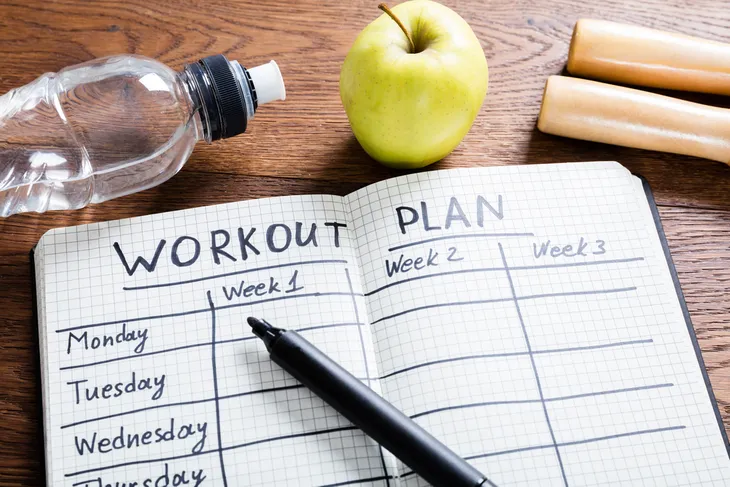It is all too common to see crowds of people migrating to the gyms and fitness centers in early summer only to wave a final goodbye to a few months later. Beginning an exercise program isn’t the hard part…it’s sticking with it that offers the greatest challenge. If falling off the wagon is becoming all too familiar, consider the following top ten tips for lifelong exercise success…
1. A Focus on Health Will Enhance Long Term Success
How many times have you joined a Spin class or CrossFit program only to run out of steam, motivation, and interest months later? Most people tend to join gyms or begin a run program with the hopes of losing weight. Unfortunately, when that doesn’t occur as fast or as effectively as they had desired, motivation wanes and they slide back into old behaviours.
The key to successful, long term exercise is a focus on health instead of weight loss or body changes. If the usual motivation to run is all about calories burned and fat lost, the health-based motivations would focus on all the great health benefits of running including gains in muscular and cardiovascular strength, stress reduction, and even an overall feeling of well-being. By focusing on health, the expectations shift from pounds lost or achieving that flat belly, to having more bounce in one’s step or the ability to run up the stairs without sucking wind. Remember, the current trend in fitness isn’t about skinny, it’s all about strength!
2. Shoulda, Woulda, Coulda…
Many of us want to want to add exercise to our daily routine. To become an active member of the exercising community is what many strive for. As a result, we “should” all over ourselves, creating an amazing amount of pressure and expectation only to submit to the siren song of the sectional (and a great movie on Netflix) with feelings of guilt and shame to follow.
In truth, shoulda, woulda, coulda causes more harm than good. The key to avoiding the drama altogether is getting real with our values and letting go of our shoulds. For example, if one values family time over gym time, is there a way to integrate those values into an exercise plan? If one values binge watching a favorite TV drama over running in the rain, is there a way of exercising in front of it? The rate of lifelong exercise success directly relates to the integration of what we value. Let’s be honest, if we are unable to merge the two, Netflix will win every time.
3. Action Planning is the Blueprint for Change
Many good intentions are not lined with the best laid plans. Many times we “just do it” without much thinking to how, when, where, why, or what. Creating an action plan for a new exercise program will serve as a map to help guide the new exerciser through the challenge of change. An action plan may include goals, barriers, likes and dislikes, time, support networks, and anything else that will support the adherence to exercise.
Although action planning takes place before embarking on an exercise program, it can be tweaked throughout the process. With any behaviour change there will be moments of clarity and many learning experiences. By altering an action plan to suit, resiliency to the change process will be strengthened as one overcomes the old habits and welcomes in the new.
4. A Little Goes a Long Way
The exciting news in exercise science suggests 30-minutes of mild to moderate exercise is all that is needed to reap the greatest health benefits. Interestingly, after 30-minutes the rate of return becomes less. This means, for someone starting a fitness program for the first time, it isn’t necessary to join the 60-minute, high intensity fitness class or even walk for an hour to begin with. Beginning with a 30-minute walk, two times per week, for one month is a great way to embark on a new active lifestyle. In fact, exercise psychologists underline the importance of only two times per week to start. Three times may overwhelm the exercise newbie and lead to drop out.
It is important to remember that beginning an exercise program is like investing your money for retirement. The small sacrifices (or investments) made today will reap amazing results tomorrow. Start slow, chose something that is comfortable, enjoyable, and relatively easy and increase the time or intensity gradually. Overtime, as the benefits of a regular exercise routine become more noticeable, sticking with the program may become second nature…just like brushing your teeth.
5. Be Safe and Educate
All too many new exercisers join the gym and work their way through the equipment without any assistance or know-how. This may not only lead to a nasty exercise injury, but ineffective training and little to no results. It is important to be aware of the latest and greatest trends in exercise before starting out on your new program.
From appropriate weight lifting techniques to proper form when running or on the elliptical trainer, education can be the difference between a back injury and a strong back. When seeking information, be sure to choose an educated and certified fitness professional and/or source. In addition, there are many sites online that provide visuals to help understand the proper form for the chosen activity. Investing in fitness knowledge is an investment in safety, health, happiness, and a long term exercise regime.
6. Find a Good Support Network
It has been noted in exercise psychology research that exercising with a friend or group is one of the best ways to ensure success. Our friends tend to keep us on track when we would rather be face to face with a tub of ice cream. Our friends are there to support us, motivate us, and listen to us when we need it.
If there is no workout buddy in sight, rally the support from home, even if family members don’t exercise with you. Perhaps it means asking for the time and understanding to exercise or asking someone else to take care of the kids for an hour. No matter what shape this support takes, it is important to plan for a social safety net to help cultivate the life habit of exercise.
7. Set Realistic Goals
Almost every article on exercise and fitness begins with the suggestion of goal setting. Yet, many of us fail to set realistic goals that support and guide us through our fitness process. The challenge with weight loss, or visual gains in fitness, is the common belief it will happen in 8- to 12-weeks or less. If these promises are not delivered by the due date, interest wanes, disillusionment sets in and the old sedentary behaviours take hold.
By creating a goal of 12-months, healthy habits have ample time to grow roots while allowing for those pesky times when you fall off the wagon. These lapses take the form of holidays, birthdays, stress, and boredom (not to mention and all those times office mates offer candy at their desks). By extending a long term goal to 12-months, there is time to learn from lapses and overcome future barriers to change.
8. Believe It or Not, Enjoyment is a Must
No theory or study in exercise psychology can offer the novice exerciser what exercise enjoyment can. If the activity is fun, we are more apt to do it. We tend to pick up an activity because our friend’s sister’s cousin’s brother lost a ton of weight doing it only to dread it more than a root canal.
The key is finding something that brings you the most joy. If it is dancing until the sweat drips on the floor do that. If it means walking and laughing with friends (until the face muscles hurt and the tears are streaming down everyone’s cheeks) do that. The key to sticking to an exercise plan is finding an activity that is enjoyable. No running, kettlebell, or CrossFit program is going to help if the dread outweighs the benefits.
9. Understand the Barriers to Change
From living with a junk-food junkie to living a life without time to breathe, there are many barriers that get in the way of our good intentions. The key to overcoming them is awareness and learning from our lapses (a.k.a. falling off the exercise wagon).
It is important to get real with what can be changed and plan for as many barriers that may get in the way of that change. By addressing barriers at the beginning of the behaviour change process, one has a better chance of being prepared to address them as they come.
10. Take a Snapshot of Current Behaviours
Taking an inventory of current behaviours allows for a greater awareness of one’s current health and life status. From recording daily diet and emotions to tracking steps, it all adds to awareness and helps to inform the behaviour change process. Time inventories are a great example of this and can help find the time we otherwise didn’t know we had.
Keeping a record of all daily activities (i.e., sleeping and eating to feeding the kids and walking the dog) can identify hidden chunks of time that could be perfect for a new exercise program. Many people are surprised to learn how much time is spent watching a screen. By reducing that time only 30-minutes less, anyone can squeeze in exercise and still have time to surf YouTube.













